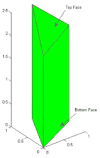Computational Aspects of Optional Pólya Tree
- PMID: 27217713
- PMCID: PMC4874344
- DOI: 10.1080/10618600.2014.1002927
Computational Aspects of Optional Pólya Tree
Abstract
Optional Pólya tree (OPT) is a flexible nonparametric Bayesian prior for density estimation. Despite its merits, the computation for OPT inference is challenging. In this paper we present time complexity analysis for OPT inference and propose two algorithmic improvements. The first improvement, named limited-lookahead optional Pólya tree (LL-OPT), aims at accelerating the computation for OPT inference. The second improvement modifies the output of OPT or LL-OPT and produces a continuous piecewise linear density estimate. We demonstrate the performance of these two improvements using simulated and real date examples.
Keywords: Bayesian nonparametrics; density estimation; recursive partition; smoothing; time complexity.
Figures









References
-
- Allaire G. Numerical Analysis and Optimization. Oxford Science Publications; 2007.
-
- Bache K, Lichman M. Uci machine learning repository. 2013;19 URL http://archive.ics.uci.edu/ml.
-
- Barron AR, Gyorfi L, van der Meulen EC. Distribution estimation consistent in total variation and in two types of information divergence. IEEE Trans Inf Theor. 1992;38(5):1437–1454.
-
- Denison DG, Mallick BK, Smith AF. A bayesian cart algorithm. Biometrika. 1998;85(2):363–377.
-
- Escobar MD, West M. Bayesian density estimation and inference using mixtures. Journal of the american statistical association. 1995;90(430):577–588.
Grants and funding
LinkOut - more resources
Full Text Sources
Other Literature Sources
